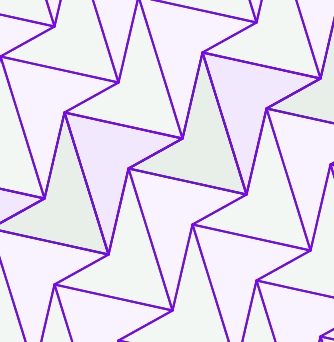Blog Posts
Here are links to posts on my Math Education Blog that you might find interesting.
If you are so moved, you may comment on the posts, and/or subscribe to the blog.
Tiling (aka Tessellation)
This is a series of three blog posts.

In the first, I argue that tiling the plane (tessellation) is a legitimate topic in school mathematics: it provides an outlet for student creativity; it teaches mathematical habits of mind; and it is a great context for basic geometry (angles, parallels, polygons, ...).
In the second post, I explain how tilings can be used to introduce rigid motions and to suggest some basic theorems in transformational geometry.
The third post is written by John Golden. It is a step-by-step GeoGebra tutorial on how to "Escherize" what starts as a simple geometric tiling.
(See also the Tiling home page on MathEd.page.)
Transformational Geometry for Teachers
This is essentially a syllabus on geometric transformations for teachers and future teachers. I outline the content teachers need to know, and how to prioritize those topics. I end with a discussion of issues that came up in conversation with fellow math educators. Read it here.
Teacher Eclecticism
In 2016, when someone complained I lacked a pedagogical framework, I agreed, and advocated eclecticism. In the real world of the classroom, teachers cannot limit themselves to a single philosophy of education, whether based on tradition, research, or the latest fad. This generated a strong response on Twitter: teachers seemed to love it, but non-teacher math educators took issue with it. This led to a couple more posts: Math Education Research, and Fads and Memes.
MathEducation.page
New on my website.
Symmetry

It is sad that symmetry is very much under-emphasized in the Common Core State Standards. It is a crucial topic in mathematics, and offers excellent opportunities for student creativity and for connections to art and culture. I now have a Symmetry home page which links to new and old materials.
- Two new units:
- - ten lessons for grades 1-6, suitable for the classroom or for a math circle, originally created for the Museum of Math's summer program;
- - and a dozen activities for middle school or high school, suitable for either in-person or remote instruction.
The page also links to existing materials throughout the site: activities in Geometry Labs; a set of paper-scissors puzzles; a spirograph simulation; and more!
Navigating the Site
I can't resist quoting math educator John Golden's comment about MathEducation.page: "Henri’s site is really the most comprehensive site any one person has made to support math teachers, while also being of utmost quality."
- Indeed, for something created by one person, the site is huge. To find things, you can search, or use one of five site maps, each organized in a different way.
- - The site's front page has images linking to many launch pages within the site.
- - The annotated map links to a selection of pages, and offers a brief description of each. It is organized into eight top-level categories.
- - There is a site map organized by grade level.
- - The comprehensive map attempts to list every single page on the site in alphabetical order.
- - I also compiled an alphabetical directory of directories.
The latter is the most recent addition. If the topic you have in mind happens to be on that list, it is probably the fastest way to get there.
Finally, there is a navigation bar at the top and bottom of almost every page. Hovering your pointer over its text and icons will provide you with many useful navigational links. Just click on those.
Improvements, Tweaks, and Updates
- Maintaining a site this big involves constant updates. Here is a very partial list of pages I tweaked in the past few months, some of them more substantially than others.
- Virtual Tangrams
- Virtual Pentominoes
- Virtual Lab Gear
- Geometry Labs
- Geometric Puzzles
- Polyomino Lessons
- Teaching
- Résumé

